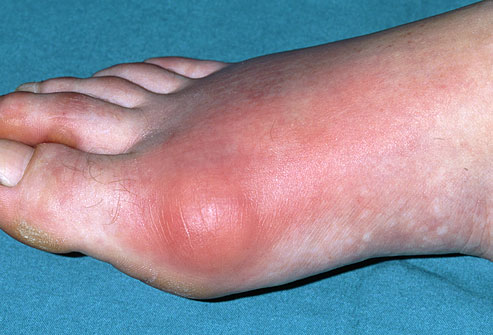Gout: Difference between revisions
No edit summary |
No edit summary |
||
| Line 30: | Line 30: | ||
There are four stages of gout, although diagnosis does not require the presence or occurance of each stage. The four stages are:<br> | There are four stages of gout, although diagnosis does not require the presence or occurance of each stage. The four stages are:<br> | ||
# Asymptomatic hyperuricemia ( serum urate > 7mg/dl)<br> | # Asymptomatic hyperuricemia ( serum urate > 7mg/dl)<br> | ||
# Acute gouty arthritis<br> | # Acute gouty arthritis<br> | ||
# Intercritical gout<br> | # Intercritical gout<br> | ||
# Chronic tophaceous gout<ref name="Goodman, Fuller" /> | # Chronic tophaceous gout<ref name="Goodman, Fuller" /> | ||
<br> | <br> | ||
Acute gouty arthritis is the most common clincial presentation and is most often found (90%) at the first metatarsophalangeal joint. Symptoms generally begin with a sudden onset of localized, intense pain, often occuring at night. The pain may be great enough to awaken the patient. Redness, extreme tenderness, and swelling around the joint will occur within a few hours of the initial pain. Hypersensitivity, chills, tachycardia, malaise, and fever may also be present.<ref name="Goodman, Fuller" /> <ref name="Goodman, Snyder" /> <ref name=" | *'''Acute gouty arthritis is the''' '''most common clincial presentation''' and is most often found (90%) at the first metatarsophalangeal joint. Symptoms generally begin with a sudden onset of localized, intense pain, often occuring at night. The pain may be great enough to awaken the patient. Redness, extreme tenderness, and swelling around the joint will occur within a few hours of the initial pain. Hypersensitivity, chills, tachycardia, malaise, and fever may also be present.<ref name="Goodman, Fuller" /> <ref name="Goodman, Snyder" /> <ref name="Beers" /> The skin may also become red or purplish, shiny, tense, and warm. <ref name="Beers" /> | ||
| |||
Occasionally, acute gouty arthritis can also occur at the fingers, wrist, elbow, knee, ankle, and instep. Even more rarely, acute gouty arthritis may present at the cervical spine, sternoclavicular joint, shoulder, hip, and sacroilliac joint. | |||
<ref name="Goodman, Fuller" /> | |||
| |||
<ref name="Goodman, Snyder" /> | |||
| |||
<ref name="Beers" /> | |||
The initial attack may last a few days to 2 weeks, if left untreated. | |||
<ref name="Goodman, Snyder" /> <ref name="Beers" /> | |||
Attacks will recur; however time periods of months or years may elapse between them. As the attacks recur, they will become more intense and may spread to other joints in the body. | |||
<ref name="Goodman, Snyder" /> | |||
| |||
<ref name="Goodman, Fuller" /> | |||
| |||
<ref name="Beers" /> | |||
A patient may eventually exprience several attacks per year. | |||
<ref name="Goodman, Fuller" /> | |||
| |||
<ref name="Beers" /> | |||
| |||
== Associated Co-morbidities == | == Associated Co-morbidities == | ||
Revision as of 22:57, 17 February 2010
Original Editors - Students from Bellarmine University's Pathophysiology of Complex Patient Problems project.
Lead Editors - Your name will be added here if you are a lead editor on this page. Read more.
Definition/Description[edit | edit source]
Gout is a metabolic disorder; however, because the clinical presentation closely resembles arthritis, gout is also classified as a form of crystal-induced arthritis. [1] [2]There are three main types of gout, all of which usually begin monoarticularly at the first metatarsophalangeal joint and are characterized by sudden pain, swelling, and redness.[1] [2] [3]
Prevalence[edit | edit source]
Effects over 2 million people in the US
The most common crystalopathy (in the US)
Rarely seen in children (< 10% of all cases) [1]
Predominantly seen in men (most common inflammatory disease in men over age 30)
Peak incidence in the 4th - 5th decades of life
Frequency increases in postmenopausal women (lack of estrogen) [1] [3]
Characteristics/Clinical Presentation[edit | edit source]
There are four stages of gout, although diagnosis does not require the presence or occurance of each stage. The four stages are:
- Asymptomatic hyperuricemia ( serum urate > 7mg/dl)
- Acute gouty arthritis
- Intercritical gout
- Chronic tophaceous gout[1]
- Acute gouty arthritis is the most common clincial presentation and is most often found (90%) at the first metatarsophalangeal joint. Symptoms generally begin with a sudden onset of localized, intense pain, often occuring at night. The pain may be great enough to awaken the patient. Redness, extreme tenderness, and swelling around the joint will occur within a few hours of the initial pain. Hypersensitivity, chills, tachycardia, malaise, and fever may also be present.[1] [3] [2] The skin may also become red or purplish, shiny, tense, and warm. [2]
Occasionally, acute gouty arthritis can also occur at the fingers, wrist, elbow, knee, ankle, and instep. Even more rarely, acute gouty arthritis may present at the cervical spine, sternoclavicular joint, shoulder, hip, and sacroilliac joint. [1] [3] [2] The initial attack may last a few days to 2 weeks, if left untreated. [3] [2] Attacks will recur; however time periods of months or years may elapse between them. As the attacks recur, they will become more intense and may spread to other joints in the body. [3] [1] [2] A patient may eventually exprience several attacks per year. [1] [2]
Associated Co-morbidities[edit | edit source]
add text here
Medications[edit | edit source]
add text here
Diagnostic Tests/Lab Tests/Lab Values[edit | edit source]
add text here
Causes[edit | edit source]
add text here
Systemic Involvement[edit | edit source]
add text here
Medical Management (current best evidence)[edit | edit source]
add text here
Physical Therapy Management (current best evidence)[edit | edit source]
add text here
Alternative/Holistic Management (current best evidence)[edit | edit source]
add text here
Differential Diagnosis[edit | edit source]
add text here
Case Reports[edit | edit source]
add links to case studies here (case studies should be added on new pages using the case study template)
Resources
[edit | edit source]
add appropriate resources here
Recent Related Research (from Pubmed)[edit | edit source]
see tutorial on Adding PubMed Feed
Extension:RSS -- Error: Not a valid URL: Feed goes here!!|charset=UTF-8|short|max=10
References[edit | edit source]
see adding references tutorial.
- ↑ 1.0 1.1 1.2 1.3 1.4 1.5 1.6 1.7 1.8 Goodman CC, Fuller KS. Pathology: Implications for the Physical Therapist. 3rd ed. Saint Louis, MO: Saunders; 2009.
- ↑ 2.0 2.1 2.2 2.3 2.4 2.5 2.6 2.7 Beers MH, et. al. eds. The Merck Manual of Diagnosis and Therapy. 18th ed. Whitehouse Station, NJ: Merck Research Laboratories; 2006.
- ↑ 3.0 3.1 3.2 3.3 3.4 3.5 Goodman C, Snyder T. Differential Diagnosis for Physical Therapists: Screening for Referral. St. Louis, Missouri: Saunders Elsevier, 2007.
- ↑ Brunilda, N. Gout Pictures Slideshow: Causes, Symptoms, and Treatments of Gout. 2008. http://arthritis.webmd.com/slideshow-gout. Accessed February 15, 2010.








